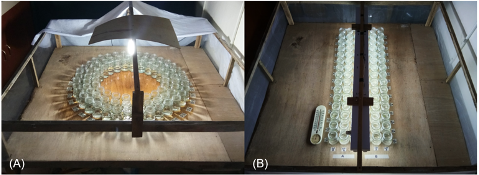VOLUME 14 NUMBER 1 (January to June 2021)

Philipp. Sci. Lett. 2021 14 (1) 119-129
available online: May 31, 2021
*Corresponding author
Email Address: jcmagahud@gmail.com
Date received: December 01, 2020
Date revised: April 29, 2021
Date accepted: May 09, 2021
ARTICLE
Growth of duckweeds (Lemna minor L.) as affected by light intensity, nutrient solution concentration, and light x nutrient interaction
Jehru C. Magahud* and Sheena Lourdes P. Dalumpines
Research Division, Philippine Rice Research Institute – Agusan,
Remedios T. Romualdez, Agusan del Norte, 8611 Philippines
Remedios T. Romualdez, Agusan del Norte, 8611 Philippines
Very limited knowledge on growth interactions between nutrient solution concentration and light intensity in Lemna have been generated. This, despite the fact that changes in nutrient solution concentration and light intensity levels are growth factors that, individually and interactively, can greatly affect the success of various Lemna ventures on ecological management. Hence, this study assessed the main effects of nutrient solution concentration and light intensity levels on growth and biomass production of Lemna. It also determined the influence of nutrient solution concentration levels on growth effects of light intensity in Lemna and vice-versa. Such growth effects were tested independently under a suboptimal growth condition of culture method 1 for seven days, and optimal growth condition of culture method 2 for nine days. Fifteen (15) fronds, reproduced from Lemna minor in Agusan del Norte, were grown in a chamber, involving the SNAPTM nutrient solution. In culture method 1, 5, 10, 15 and 20% nutrient solution concentrations were evaluated. Lemna were placed at various distances – 37 cm for low light intensity, 30 cm for medium light intensity, and 23 cm for high light intensity – from lamps that emit 169 and 16 µmol photons/m2/s for 15 and 9 hours, respectively. In culture method 2, 0, 5, 10, 15 and 20% nutrient solution concentrations were examined. Lemna were placed at various distances – 20 cm for low light intensity, 15 cm for medium light intensity, and 12 cm for high light intensity – from lamps that emit 49 µmol photons/m2/s for 24 hours. Nutrient solution concentration and light intensity have significant main effects on Lemna growth under suboptimal and optimal growth conditions. Highest growth or maximum growth point is achieved at a certain nutrient solution concentration. Growth continuously declines as nutrient solution concentration is either successively decreased below, or successively increased beyond the maximum growth point. Highest growth or maximum growth point is attained at a specific light intensity; growth declines if light intensity is either increased or decreased from the maximum growth point. Nutrient solution concentration and light intensity can have a significant interaction effect on Lemna growth under optimal growth condition. The magnitudes of positive growth effects of light intensity on nutrient solution concentration become greater in higher than lower nutrient solution concentrations as light intensities increase from lower levels to the maximum growth point. The degrees of positive growth effects of nutrient solution concentration on light intensity become bigger in higher than lower light intensities as nutrient solution concentrations increase from lower levels to the maximum growth point. Information derived from this study can be used by Lemna researchers to formulate better strategies or methods in evaluating and reducing health risks, and in managing populations of species.
© 2024 SciEnggJ
Philippine-American Academy of Science and Engineering